Menus
- French watch or Gallic genius ?
- 128 hp Honda Moto2 engine, parallelogram suspension front axle, adjustable geometry, solid 7075 T6 aluminum chassis, 154 kg
- France and unconventional front gears
- Discovery
- Test
- Conclusion
French watch or Gallic genius ?
128 hp Honda Moto2 engine, parallelogram suspension front axle, adjustable geometry, solid 7075 T6 aluminum chassis, 154 kg
There are standard motorcycles and then those which open up new avenues, particularly at the technical and mechanical level.. This is exactly the case for the manufacturer Nard with his sporty Moto2 Ultra 6, with its parallelogram suspension front axle and ultra-minimalist frame design.
But it’s good to admire but it’s even better to try! So when I received the invitation, I immediately jumped on the plane to join the Croix-en-Ternois circuit. The Nard Ultra 6 is quietly waiting for me in the paddock.
Why Nard? Named after its designer and former hydroelectric civil engineer Gilles Nard 71 years old. His sons Sebastien and Julien are also in the game, with a design strategy that, everywhere except in France, would be considered unnecessary at best and laughable at worst. What’s wrong with telescopic forks anyway ?
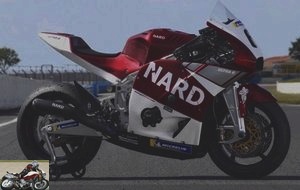 Test drive of the sports car Nard Ultra 6
Test drive of the sports car Nard Ultra 6
France and unconventional front gears
Now, there’s got to be something in the wine or in the mineral water. Because it is especially in France that we find these new directions and solutions, more than in any other country with this paradox: France is the largest European market for motorcycles and yet no longer has a motorcycle industry! And it is also in France that we find both innovative and avant-garde approaches to motorcycle chassis and a commitment to competition. The successive examples of alternative thinking that have come out of national workshops over the past half-century are for the most part not mere fanciful follies that just want to be different. Instead, they’ve often come up with a real solution to this age-old conundrum: How do you make something that works well today even better? At the stage where major manufacturers such as Honda and BMW have adopted elements of these revolutionary designs on their production models, the alternative French chassis technology deserves to be recognized as a crucible for developing a better motorcycle..
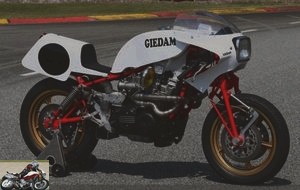 The 1978 Yamaha XS1100 Fior
The 1978 Yamaha XS1100 Fior
This is how Pierre Doncque’s Kawasaki Godier & Genoud, winner of the Bol d’Or 1975 with its tubular steel perimeter frame completed by a progressive rear suspension, resulted in the format of the double-spar frame which has now become a common element on most production sports cars. We can also talk about the one-sided swingarm launched by Andre de Cortanze in the design of the ELF endurance sports car, which was also the first to run with carbon brake discs. This is another of the many ELF patents acquired by Honda to produce the RC30, RC45 etc. Then there was the BMW K-series Duolever front suspension launched in 2004, a direct copy of the parallelogram fork invented 25 years earlier by Claude Fior. The same front axle adorns the Brough Superior models produced in Toulouse today and will also be present on the Aston Martin AMB 001 motorcycle, which is due to start production. Oh and John Britten used it for his jaw-dropping V-twin designs as well. Even the most traditional English commentators, who like to laugh at what they call "funny French forks", must recognize the importance of the Gallic engineers’ clear refusal to hold on to what has been learned by pushing the limits of the design of the chassis, with obvious advantages for everyone.
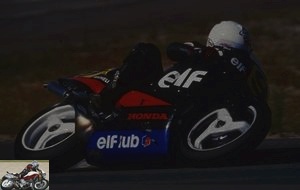 Ron Haslam on ELF3 in 1986
Ron Haslam on ELF3 in 1986
We can also talk about the eternal embrace of non-compliance by Eric Offenstadt and his multitude of GP sports monocoque frames equipped with disc brakes and cast wheels, which he was the first to market, until ‘to the 2017 Geco R15 built around a YZF-R1 engine supplied by Yamaha Europe. But we can also talk about the series of endurance sports cars and 500 GP competitors financed by the French oil giant ELF, or the range of road and track motorcycles equipped with the Fior fork. France has a tradition of the unconventional in the design of motorcycles. Tradition of which the Nard Ultra 6 is an integral part.
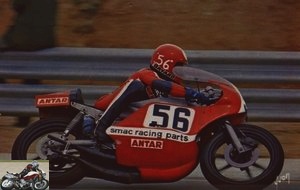 Eric Offenstadt and his SMAC Kawasaki 500 monocoque
Eric Offenstadt and his SMAC Kawasaki 500 monocoque
Discovery
Last August, Eric de Seynes expressed his confidence in Nard’s design by having the tri-tuning fork manufacturer supply another R1 engine to the team to allow them to build their own endurance prototype which, without the Covid-19, should have already performed its tests to participate in the 2020-2021 world events. Although the Nard Ultra Y1 prototype was presented in embryonic form to the 72,000 visitors to the Lyon 2 Roues Show last February, its track debut is still a long way off. The opportunity to drive his predecessor in Moto2 format at Croix-en-Ternois allowed me to assess the qualities of the Nard Engineering chassis..
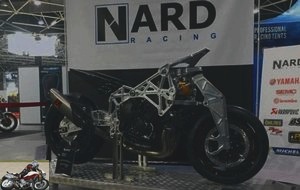 The Ultra Y1, Nard’s next project based on a Yamaha YZF-R1 engine
The Ultra Y1, Nard’s next project based on a Yamaha YZF-R1 engine
The Nard Ultra 6 was designed by Gilles Nard in his hometown of Clermont-Ferrand in 2014 after what he grimaced as "a difficult year of total immersion in design". His creation finally came to pass, although this did not happen until after Nard Engineering was officially founded and his two sons joined him:
Initially, I hoped to create it in my garage at home, using subcontractors to produce the components necessary for my design. But after being constantly disappointed with the different suppliers in terms of time and execution, I decided that we had to do everything ourselves. I bought a CNC machine to allow us to machine our own metal components, as well as an autoclave for all the carbon fiber parts like the casing, air ducts, struts and guards. mud. We built everything in-house on this bike except the engine, electronics, brakes, wheels and suspension..
As Clermont is also the birthplace of Michelin, it’s easy to guess which tires are fitted to the Nard. !
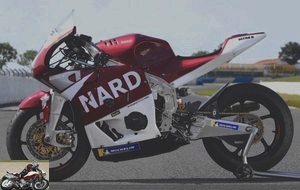 The Nard Ultra 6 is developed on the basis of Moto2
The Nard Ultra 6 is developed on the basis of Moto2
The choice to create a Moto2 was made because it was the most cost effective and reliable way to demonstrate the validity of the Nard design. But the replacement of the Honda four-cylinder engine derived from the CBR600RR with the Triumph 765cc three-cylinder must have been a setback ?
No, because not only can we still race in Spain where Moto2 races are still done with the Honda engine, but also because we are allowed to race in France in Supersport 600 … without however being eligible to score points..
It is on this basis that the then just completed Nard Ultra 6 made its racing debut in October 2017 on the occasion of the last round of the Ultimate Cup 600 at Magny-Cours, piloted by Erwan Quellet, pilot of the Michelin test sent by the French manufacturer as part of its support for the project. Quellet qualified sixth on the Nard which he had never driven before this weekend. He retired from the first race three laps from the finish due to a problem with the front brakes while in third place, then struggled for victory before falling on the penultimate lap of the second race after an overly ambitious overtaking attempt. Not a bad start !
 The chassis developed by Nard in detail
The chassis developed by Nard in detail
This performance demonstrated that the Nard design has real potential. Quellet believing in the project, continued to test the bike while Nard Engineering painstakingly developed the concept. Along the way, the original Honda engine was tuned to Moto2 specifications by Brancquart Competition in Marseille. It now delivers 128 hp at 15,000 rpm, much less than the freer Supersports which run a few seconds faster at Magny-Cours. At the end of 2018, the Ultra 6 was ready to roll, but the lack of budget of over € 6,000 needed for each race in Spain put the brakes on the project. It was then that Eric de Seynes proposed a more publicized engine which, as Gilles Nard hopes, should make the search for sponsors "easier"..
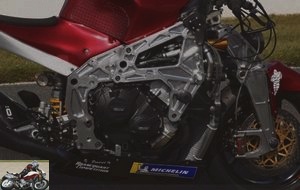 Honda CBR600RR engine has been brought into conformity with Moto2 regulations
Honda CBR600RR engine has been brought into conformity with Moto2 regulations
The Nard Ultra 6 that I drove in Croix-en-Ternois has the prepared Honda engine, fitted with a Ten Kate Racing ECU and a SC-Project 4-1 titanium exhaust, which is used in the frame as an element under pressure. It is thus sandwiched between two plates of 7075 T6 aluminum alloy cut in the mass. Pivoting at the bottom of each plate is a double CNC-machined swingarm from the same aircraft material, with a fully adjustable Ohlins TTX36 damper and progressive rate linkage. Above, the self-supporting carbon fiber subframe features the 820mm high saddle behind the 16-liter aluminum fuel tank. All these items are made by Nard.
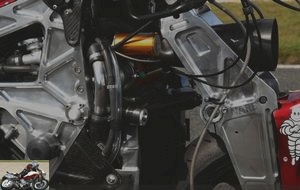 The Fior type front suspension is based on a Цhlins TTX shock absorber
The Fior type front suspension is based on a Цhlins TTX shock absorber
The OZ Racing forged aluminum wheels are shod with Michelin Power Cup Ultimate tires, with a thick 190 / 55-17 at the rear on a 6-inch rim. The Brembo brake package features two 320mm steel floating front discs with radial mounted 4-piston Monoblock GP4 RR calipers as well as a 220mm rear disc with a two-piston radial caliper. The Ultra 6 weighs 154 kg with oil and water, but without fuel with a weight distribution of 55/45% static. This extreme distribution results from the design of the front axle which does not cause the fork to deflect when braking and therefore no risk of the front wheel coming into contact with the exhausts or the engine. The latter can thus be placed further forward in the wheelbase to optimize weight distribution..
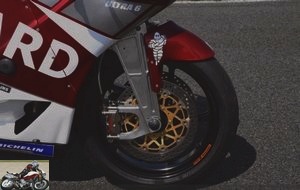 The Nard is fitted with OZ Racing wheels and Brembo brakes
The Nard is fitted with OZ Racing wheels and Brembo brakes
When I rode it, the wheelbase had been reduced to 1,370 mm compared to the 1,395 mm of Magny-Cours in order to offer a little more handling on the narrow 1.91 km track with two hairpin turns. at each end of the short 650m straight line. This is easily done thanks to an intelligent system for adjusting the length of the oscillating arm over a range of 38 mm, which makes it possible to vary the latter between 1.365 and 1.403 mm! The system makes you wonder why it is not more common when you see it. This very high degree of tuning is the main objective pursued by the Ultra 6 chassis, which also helped Gilles Nard to determine his choice of front suspension..
 The Nard Ultra 6 is very compact with only 1,370 mm of wheelbase
The Nard Ultra 6 is very compact with only 1,370 mm of wheelbase
The front of the Nard represents a version cut in the mass of the parallelogram fork of Claude Fior, invented in 1978 to counter the imprecise direction of the Yamaha XS1100 with which he rode in endurance. It is often confused with the similar Hossack front end developed later by Zimbabwean engineer Norman Hossack, who then rode a Yamaha TZ350 in the UK while working as a racing mechanic at McLaren in Formula 1. That is so in 1979 he had the idea of adapting the parallelogram suspension of a racing car to a motorcycle, by rotating it by 90 °. But although Hossack managed to patent the design in 1984 (but then let it expire to allow BMW to adapt it on the first K1200S without paying him royalties …), it should never have been. allowed. 18 months earlier, Claude Fior had developed an identical front suspension design but had not bothered to patent it. Even before Hossack built his first bike with this design, Fior had already scored points in the Endurance World Cup on his Fior-Yamaha..
Gilles Nard :
Like John Britten, I have always admired the Fior fork not only because of the separation of steering and damping functions, as well as the high degree of tuning inherent in the design, you can make very fine tweaks to the settings. But I also like it because it allows greater centralization of the masses in the motorcycle. Thanks to this, I have compressed the center of gravity and the center of mass to the maximum, which gives a more precise and agile handling. In addition, we can use a very sophisticated shock absorber which offers a greater degree of adjustability and better tuning than a telescopic fork..
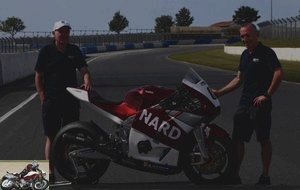 Gilles and Sebastien Nard alongside their sporting creation
Gilles and Sebastien Nard alongside their sporting creation
This is the key element of the Nard Ultra 6: the adjustment possibilities. In addition to the settings for the rear suspension, the rear ride height (which in turn affects the geometry of the front axle), the swingarm length (and therefore the weight distribution, traction and wheelbase) and the height of the swingarm pivot (variable over a range of 5 mm), the use of the Fior type front axle with its fully adjustable and transversely mounted Ohlins TTX36 shock absorber with a progressive rate link, offering a travel of 120 mm of the wheel, allow other settings to be varied very quickly and with precision. Front ride height, caster angle, anti-dive, offset and weight can all be changed mechanically very quickly. This is a particularly important advantage in categories where no aftermarket motorcycles are allowed, so adjustments only need to be made on one machine. This allows very rapid changes to be made for meteorological reasons or track conditions. Add zero deflection to braking, so constant steering geometry, improved stiffness to weight ratio and reduced unsprung weight up front compared to a telescopic fork and you can enjoy its benefits.
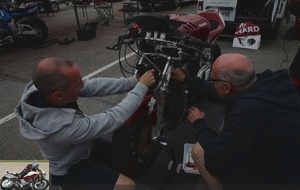 The Nard chassis is distinguished by its adjustment possibilities
The Nard chassis is distinguished by its adjustment possibilities
But for me the big advantage of the Fior fork has always been the extreme braking coupled with the control it offers. I must say that I have believed in this system since the very first time I tried it. I had the honor of being a friend of Pif, as this Gallic genius was universally known and I tested every variant of his design, from the XS1100 racing sportswoman to his own 100% French motorcycle Fior 500 GP, motorcycle on which Marco Gentile finished tied on points with Randy Mamola then on Cagiva in the 1989 500 GP World Championship. Fior had managed to compete with the billionaire Italian team (in lire) to become the best European motorcycle, with a budget that had nothing to compare.
Test
So I couldn’t wait to drive the Nard Ultra 6. But my first 20-minute session at Croix was a huge disappointment. The bike seemed terribly unstable in the curves, especially in the two right bobby pins at the ends of the straight so I could only use the braking potential of the Fior train in a straight line. As soon as I entered the turn, she was nervous and unpredictable. At first, I blamed it on the new Michelin Power Cup Ultimate tire set which was taking a long time to build. It was my first time riding these tires and they took a long time to heat up even after spending an hour under electric blankets. Fortunately, Gilles and Sebastien, standing at the edge of the track, could see for themselves what was happening, because the bike threatened to lose the front on each lap..
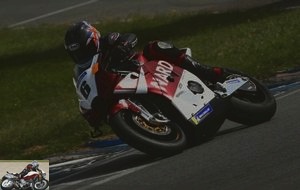 For the first session, the Ultra 6 proved to be particularly difficult in turns.
For the first session, the Ultra 6 proved to be particularly difficult in turns.
Ok, back to square one and now what ?
The Nards decided to lengthen the drag from 94 to 104 mm, a change that would normally take 30 minutes on a conventional motorcycle but which only took here a third of that time, without having to dismantle the front axle to change the triple tees.
The next session the bike looks better, but at the cost of reduced agility by requiring more effort to get it from angle to angle in the right / left before the final hairpin. But back in the paddock, the Nards were all smiles, not for my still average performance on their bike, but because they had just realized what had happened. By installing new brake pads for the test, they inadvertently fitted the wrong type and it stayed in contact with the rotors once the temperature rose causing what amounted to brake drag when I released. the lever to enter a turn. Okay, but with the separation of braking and steering thanks to the Fior fork, shouldn’t that not matter? Either way, all I can say is that it was !
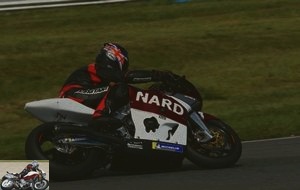 It only takes about ten minutes to change the drag and increase the wheelbase of the bike
It only takes about ten minutes to change the drag and increase the wheelbase of the bike
With the old brake pads reinstalled for my third session, I was finally able to exploit the full potential of the Nard chassis. By twirling around the bends and hampering the other group members during this day on the track, I can now savor the real benefits of the Nard design. !
The strong point remains its braking performance. Because not only does the Brembo package now work as it should have from the start, coupled with a significant amount of engine braking left in the settings of the Suter slip clutch without causing rear wheel movement, but I can also take advantage of the advantage of the Fior system by braking always hard and far to the point of rope, which allows to overtake other riders who had already released the brakes of their conventional motorcycle. This is particularly useful in Turn 1 at the end of the straight line where a damaged area is present on the ideal course, just at the chord point of the hairpin turn. To avoid it, everyone spends wider and wastes precious time. But the NARD front suspension allows me to go inside quickly while braking while maintaining my acceleration longer when others are already starting to brake. So I can continue to squeeze the front brake lever up to the chord point, including going over the area that the Ohlins front shock absorber absorbs without the Michelin tire below losing grip. In fact, I barely feel the bumps through the handlebars. After making this turn taking less angle, I can now pull the accelerator harder and much earlier to get out faster when others are playing it safe by taking a wide trajectory. The speed reached in the short straight is thus much higher..
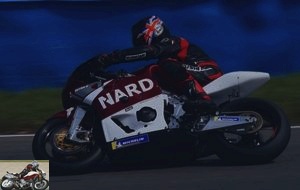 Once the problem has been corrected, the Nard proves to be formidable in curves.
Once the problem has been corrected, the Nard proves to be formidable in curves.
By braking hard while using the Suter clutch to downshift the Ten Kate Supersport gearbox, the Nard still conveys that braking feel with a small, but noticeable, front dive left by the team. The Nard / Fior design has an inherent anti-dive that can be changed at will, while keeping the wheelbase constant under braking.
I remember that during my three years of racing on the Bimota Tesi, it took me a long time to get used to this total lack of diving when braking, the bike always remaining flat, as if at a standstill. However, we could not change the low level of diving allowed by the Nard’s Fior system without affecting the tuning of the suspensions. If a trace of lift from the rear starts to be felt as I gradually brake later and later with each lap, I can counter that by applying the rear brake just before cornering the front lever. This allows just the right amount of weight to be transferred back. The Nard is now perfect in its braking, without the slightest trace of instability. I guess my extra pounds compared to Erwan Quellet didn’t bother either !
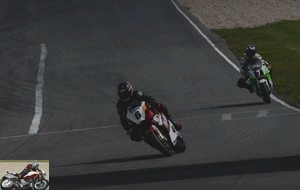 The front axle of the Fior type allows to brake very late and here keeps a short dive
The front axle of the Fior type allows to brake very late and here keeps a short dive
The engine prepared by Brancquart is a gem, pulling hard from 8,000 rpm, with linear power until the gearshift indicator light starts flashing at 15,000 rpm, giving me time to shift into gear. upper via the stroke shifter before reaching the 16,500 rpm limit. I would have liked an extra tooth on the rear sprocket to ensure a stronger drive in second on the two hairpin turns as it has a bit of trouble picking up below 7,500 rpm. Coming out of turn 1 in second, I could hold it until the second turn by cranking the engine at 16,500 rpm to save some gear changes. Maybe it was better to adjust the gears a longer.
The riding position is also nice, with the handlebars flat enough to give extra leverage through the countless slow corners on a track as tight as this one. The Fior type fork gives more freedom to give a short wheelbase motorcycle a relatively spacious position. Even if it remains compact on the Nard, a pilot even taller than me (1m80) will not feel cramped.
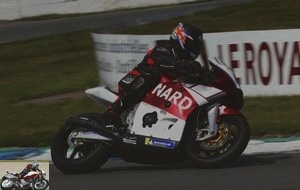 The CBR engine accelerates hard at 8,000 rpm
The CBR engine accelerates hard at 8,000 rpm
Yet in the only two reasonably quick corners on the short circuit, the Esses of Turns 4 and 5, the Nard seems balanced as I lean side to side. Although we have now corrected the behavior on a curve, I would have liked to go back to the initial settings to see if it was able to gain agility without losing stability elsewhere. I also feel the bike understeer out of turn 5 when I accelerate too much, forcing me to slow down a bit to get it back on track with braking for the slow right turn looming. Unfortunately, I didn’t have the time to do it, having to hand over the Nard to a more illustrious rider, Martin Wimmer, 63, winner of three Grands Prix 250 when he was a factory rider for Yamaha, Aprilia and Suzuki.
Conclusion
My time spent on the Nard Ultra 6 after correcting the initial problem was long enough to be impressed with this bike, but also short enough to be frustrated, especially without being able to start experimenting with the parameters that were so quick to change on this design. I take my helmet off to the Nard family for taking the Fior front end to the next level, making it so quick and convenient to adjust, while still retaining its benefits. The most critical aspect of handling a motorcycle is entering a corner as quickly as possible and maintaining speed. The Moto2 version of the Nard design certainly seems to have achieved this goal. I am now looking forward to my promised ride on the Yamaha R1-powered Ultra Y1. This time I will have more time to experiment with all the possible settings !
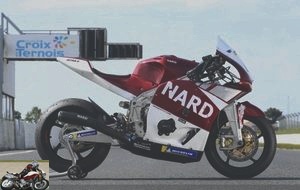 The Nard Ultra 6
The Nard Ultra 6
Strong points
- Maneuverability
- Cycle part
- Braking
- Adjustment possibilities
Weak points
- Slightly short reports
The technical sheet of the Nard Ultra 6
Related articles
-
Ducati Monster 620 motorcycle test
Biker testing: Garfield Ducati and me, it’s a long platonic love story. Between in high school in the late 80s, the teenager I was did not fail to swoon…
-
MV Agusta Superveloce 800 motorcycle test
Neo-retro in the right tempo 3 cylinders of 798 cm3, 148 hp, 88 Nm, 173 kg, 20,300 euros Concept bike adapted in an ultra exclusive limited series, the…
-
Alternative American-style engineering 3 cylinders in W at 45 ° x 45 °, 2.472 cm3, 154 hp, 236 Nm, 268 kg California is teeming with talented tuners, all…
-
Curtiss P40 Warhawk Final Edition motorcycle test
First and last 2.163 cc V-Twin, 156 hp and 217 Nm, 247 kg full made, $ 75,000 Curtiss Motorcycle Co. , named after legendary American biker and aviation…
-
Ducati Monster motorcycle test
Salon revolution V-Twin Testastretta of 937 cm3, 111 hp, 93 Nm, 166 kg dry (188 kg full made), 11,290 euros Is a Monster still a Monster if it doesn’t…
-
Ducati 1098 motorcycle test – 160 hp in free version
There are times in a biker life where the emotional strikes, in the heart ! I remember when the 916 was released : what a slap! A stroke of genius signed…
-
Royal Enfield Meteor 350 motorcycle test
Entry-level, extra class Air / oil single cylinder, 349 cm3, 20 hp and 27 Nm, 191 kg full made, from 4.099 euros Royal Enfield commemorates its 120th…
-
Yamaha XT 660 R motorcycle test
City rat who knows how to transform into a field rat From the first letters, the XT informs that its history is loaded with lasting memories. Today XT…
-
Yamaha VMAX Cafe Racer motorcycle test
Rocket hyper modified by Roland Sands Design The Power Cruiser stripped down to lose 36 kg The Yamaha VMax is undoubtedly one of the most iconic…
-
Yamaha RZV 500R motorcycle test
GP 500 2 stroke … road ! 50 ° V4, 494 cc, 100 hp, 134 kg Sports bikers are familiar with the Yamaha RD 500 LC, inspired by Kenny Roberts’ YZR500….